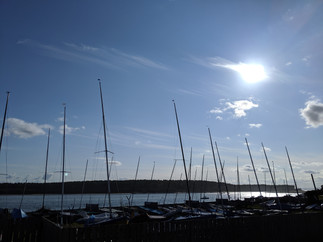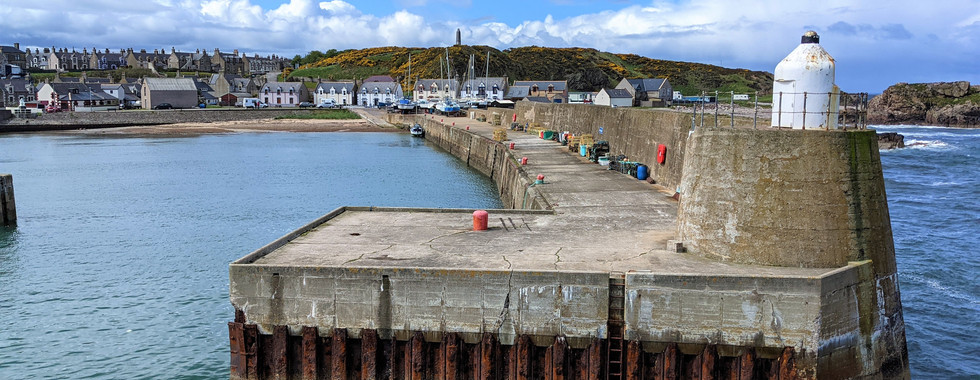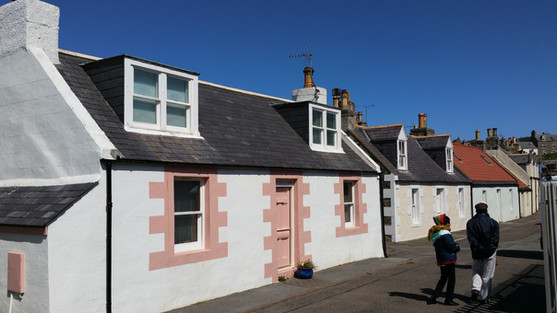Discover Your Backyard – The Picturesque Fishing Communities of Moray, Scotland
- Barry Pickard

- Oct 16, 2025
- 10 min read

Author: Barry Pickard
Hi, I'm Barry, the owner of Tailor-Made Itineraries and I have been designing bespoke self-guided tours for adventurous and curious travellers since 2015. I am a history graduate with a passion for travel.
I created this blog to show, through my own adventures, how you can have an incredible travel experience as an independent traveller, giving you the information to navigate the world with confidence.
Where can you find Scotland's most charming fishing villages that haven't been overrun by tour buses or turned into tourist theme parks? The answer lies along the rugged Moray coast, where a string of authentic harbourside communities still echo with the voices of generations of fishermen who once hauled silver herring from the North Sea.
Close your eyes and imagine this: the sharp tang of salt spray mingles with the sweet smoke drifting from cottage chimneys as fishing boats bob gently in tiny stone harbours designed by Thomas Telford himself. You hear the rhythmic clang of rigging against masts, punctuated by the harsh cry of herring gulls wheeling overhead. Beneath your feet, worn cobblestones still glisten with morning dew, while weathered fisher cottages painted in faded blues and yellows huddle together like old friends sharing centuries-old secrets. This isn't some sanitized heritage attraction - it's the real deal, where working harbours still smell of diesel and rope, and where you might catch a glimpse of langoustine boats heading out for the European markets.

You've found exactly the guide you need to explore these hidden coastal gems. I'm Barry, and I've been personally visiting and researching these Moray fishing communities for years, not as a day-tripper snapping quick photos, but as someone who's lingered over pints in 18th-century inns, traced the evolution of each harbour's stone walls, and even chatted with locals about their families' fishing heritage. As a history graduate who's been designing self-guided tours since 2015, I've walked every quayside from Findhorn to Sandend, discovering which villages offer the most authentic experiences and where to find the best vantage points for that perfect photo.
If you're an independent traveller who prefers discovering genuine coastal culture over crowded tourist hotspots, this detailed guide will take you through ten distinctly different fishing communities along the Moray coast. I'll share the insider knowledge I've gathered from my own explorations - from the historic inn that's been serving travellers since 1739 to the tiny village where a bronze fisherman still watches over the harbour. These aren't just pretty postcards - they're living communities with stories that stretch back to medieval times, Viking battles, and royal tragedies.
Tailor-Made Itineraries delights in creating bespoke self-guided tours. So, if visiting Moray appeals to you, reach out to me by email. I would be more than happy to design a self-guided tour around your requirements incorporating Moray’s attractions, or indeed, a general tour of Scotland.
The History of Moray's Fishing Communities
Moray is the region between The Highlands and Aberdeenshire in Scotland and is fast becoming a must visit destination, but for several hundred years, fishing was an important industry along the Moray coast, with salmon and herring being caught in sufficient quantities to be exported into Europe. Many small fishing communities sprouted up along the coast to exploit this profitable industry during medieval times.
The herring boom may have peaked by the start of the 1900’s, but efforts quickly switched to trawling and seine-netting during the turn of the century. However, technological advances increased the size of fishing ships, outgrowing many of the small harbours, and at the same time these advances increased efficiency, reducing the number of fishermen required. Sadly, commercial fishing then began to disappear from many of the villages and towns of Moray, often leaving them as picturesque tourist destinations or dormitories to the larger towns in the area.
Today commercial fishing in this area is mainly operated through the nearby ports of Fraserburgh, Peterhead and to a lesser extent, Aberdeen. Indeed, around half of the fish landed in Scotland come into these harbours of the North East.
If you this post, then check out our previous blog post on the fishing villages of Aberdeenshire.

The Picturesque Fishing Communities of Moray
Findhorn
Findhorn sits on the eastern shore of the beautiful Findhorn Bay and was erected into a burgh of barony by act of Parliament in 1661. In the seventeenth century Findhorn was the principal seaport of Moray and vessels regularly sailed to and from all parts of the North Sea and as far as the Baltic Ports. Changes to the narrow and shallow entrance to the Bay created obstacles to navigation and as the size of trading vessels increased so the volume of trade to the village declined. By the nineteenth century fishing predominated. This industry also went into decline and today Findhorn is more of a dormitory suburb and more famous for the spiritual community of the Findhorn Foundation.
Tailor-Made Top Tip: Visit Findhorn’s oldest building - The Crown and Anchor Inn – which dates from 1739 and enjoy a pleasant drink and hearty meal.
Burghead
Burghead's history stretches far back to a time when its hillfort was most likely the capital of the Pictish Kingdom of Fortriu. Evidence of settlement can be found as far back as 300AD, however, much of this was wiped away when the modern town of Burghead was built between 1805 and 1809. Construction on the harbour was commenced in 1807 based on the designs of Thomas Telford. Indeed, today three of his original storehouses still stand at the side of the harbour. Fishing, particularly herring fishing, was a large part of the town's economy and up to 40 fishing boats used the harbour in the 1830s. Today, Langoustine fishing for the European market is now the only significant fishing industry in Burghead.
As well as its Pictish fort and carved stones, Burghead is also famous for its fire festival - The Burning of the Clavie - which greets the New Year on 11 January. The waters around the town are also rich in sealife, with whales, dolphins, porpoises and seals being regularly spotted.
Tailor-Made Top Tip: Make sure to go the Burghead Visitor’s Centre for a great introduction to the town’s fascinating history.


Hopeman
Hopeman was founded in 1805 to house and re-employ people displaced during the Highland clearances. Initially built as a fishing port by William Young of Inverugie, it was expanded when the new harbour was built in 1838 for the export of stone from the nearby quarries.
If you are enjoying this post, remember and subscribe to my mailing list to receive my latest blog posts.
Lossiemouth
Lossiemouth, often referred as 'the jewel of the Moray Firth', is blessed with two sandy beaches, glorious dunes and beautiful countryside. With over 1,000 years of settlement in the area, the present day town was formed over the past 250 years and consists of four separate communities that eventually merged into one.
By the end of the 17th century, the Seatown settlement at Lossiemouth was established as a port for the town of Elgin, 6 miles away. A new jetty was built in 1764, but tragedy struck on Christmas Day 1806 when three fishing boats perished with a loss of 25 men, leaving 17 widows and 47 orphaned children. It wasn't until a new harbour was built at Stotfield Point in the 1830's that fishing and trade really started to develop, with many fishing families relocating to the town.
Lossiemouth holds a fishing claim to fame, with one of its sons, William Campbell, having designed the immensely popular Zulu fishing boat in 1879, a mainstay of the herring fishing industry until the introduction of the steam drifter. Another famous son of Lossiemouth was James Ramsay MacDonald, who was born in the town in 1866 and went on to become the first British Labour Prime Minister.
Tailor-Made Top Tip: If you are in need of refreshments, the Windswept Brewery has a lovely little tap room that you can visit and sample their fantastic range of beers.
Portgordon
The village of Portgordon was founded in 1797 by Alexander, 4th Duke of Gordon. In 1928 there had been around 40 boats using the harbour, but this declined dramatically after the Second World War. The harbour was closed and fell into neglect, but in 1985 the 69th Gurkha Independent Field Squadron was commissioned to rebuild the harbour and the harbour is now managed by a community action group and is used by small pleasure craft.
Buckie
Buckie is a burgh town on the Moray Firth and is the third largest town in Moray. The earliest mention of the town was made in 1362, and by the 1900's, Buckie was a thriving port, focusing on fishing and shipbuilding. By 1913 Buckie had the largest steam drifter fleet in Scotland. Food processing remains important and there is a successful shellfish industry.
Tailor-Made Tip: Visit the Buckie and District Fishing Heritage Centre for more information on the fishing industry.
If you are enjoying this post, remember and subscribe to my mailing list to receive my latest blog posts.
Findochty
Findochty is a village in Moray, on the shores of the Moray Firth. One of the earliest references to Findochty is in 1440, when the king granted Findachtifeild to John Dufe, son of John Dufe. Findochty expanded as a fishing port through the 1700s and 1800s, and by 1850 was home to 140 fishing boats. But the expansion in the late 1800s of nearby Buckie provided a better harbour, and some of the fishing fleet had left Findochty by 1890. Findochty harbour is now used mostly by pleasure craft. A local artist, Correna Cowie, created a statue in 1959 of a seated fisherman, known as The Mannie, who watches over the harbour.
Tailor-Made Top Tip: The Admiral’s Inn is an excellent stop for a bite to eat.
Portknockie
Portknockie, which means 'the hilly port' in Gaelic, was founded in 1677 and became a significant herring fishing port during the nineteenth century.
Tailor-Made Top Tip: Make sure to visit the Bow Fiddle Rock, which is one of Scotland’s most memorable sights.

Cullen
Cullen is a quiet seaside holiday resort, with stunning scenery, long beach and calm waters. Cullen has a long history, with it first appearing in recorded history in 962. It was noted that during this year, the Battle of the Bauds was fought between the Scots King Indulf and the Vikings, where the unfortunate king lost his life. Another royal, this time King Robert the Bruce’s Queen, Elizabeth de Burgh, also died nearby, in 1327. Indeed, her entrails remain buried at the original church.
By the late medieval period, Cullen became a centre of fishing, and by the 1600’s, the quaint fishing cottages in the Seatown area were being built. The industry then experienced a dramatic growth during the 1800’s. The new harbour was completed in 1819, to a Thomas Telford design, with an additional quay being built in 1834. This complemented the creation of the new town of Cullen, which was constructed between 1820 and 1830.
Tailor-Made Top Tip: For an excellent meal, look no further than the Seafield Arms Hotel, which offers exceptional food and service.
Sandend
Sandend is perhaps the smallest of the many old fishing villages scattered along the north-facing coasts of Moray and Aberdeenshire. Although actually in Aberdeenshire, Sandend is so close to Cullen and so cute, we decided to include it anyway! The gorgeous beach here is popular in summer with families and with surfers and extends about half a mile to the east. The oldest part of Sandend huddles around the south side of its harbour. The village actually predates many of the much larger towns and villages along this coast, being very well established by the early 1600s. The harbour you see today was constructed in the 1800s, and it seems likely that most of the fisher cottages that huddle around it, end on to the sea, date back to around the same time.
If you are enjoying this post, remember and subscribe to my mailing list to receive my latest blog posts.
Conclusion
After exploring these fishing communities along the Moray coast, what strikes me most isn't just their undeniable charm, but how each village tells its own unique chapter in Scotland's maritime story. From Findhorn's transformation from medieval seaport to spiritual community hub to tiny Sandend's timeless appeal that's remained virtually unchanged since the 1600s, these harbours represent an authentic Scotland that's increasingly rare in our tourism-saturated world. The beauty of visiting these villages lies in their accessibility - you can park right beside Thomas Telford-designed harbours, walk cobblestones worn smooth by generations of fishermen's boots, and enjoy a pint in pubs that have been serving travellers for centuries. Unlike the crowded tourist magnet fishing villages elsewhere in Scotland, these Moray communities still feel lived-in and genuine, where you're more likely to encounter working boats than tour groups. Whether you're watching dolphins from Burghead's harbour or exploring the quaint Seatown cottages of Cullen, you're experiencing coastal Scotland as it was meant to be discovered - at your own pace, with your own curiosity as your guide.
If you this post, then check out our previous blog post on the fishing villages of Aberdeenshire.
Accommodation Suggestions
A great day trip can be enjoyed in Moray, but to really appreciate this region, we would always recommend spending three to ten days. We have been lucky enough to stay at two great properties on Moray coast and can highly recommend them:
Glamping at The Loft, near Kinloss
Self-catering at Speyside Cottages (properties in Dufftown and Findochty)
**Disclosure: We have been guests at both properties. Regardless of this, please be advised that our recommendation is genuine and authentically our own.**
Tailor-Made Itineraries delights in creating bespoke self-guided tours. So, if visiting Moray appeals to you, reach out to me by email. I would be more than happy to design a self-guided tour around your requirements incorporating Moray’s attractions, or indeed, a general tour of Scotland.
Related Blog Posts
If you are interested in finding out more about the Moray and Speyside regions of Scotland, please view the Tailor-Made Itineraries posts below:
Tailor-Made Top 9 Whisky Related Activities in Speyside (That Do Not Involve Visiting a Distillery!)
Which Moray fishing village captured your heart most - share your coastal discoveries and favourite harbour memories in the comments below!
Tailor-Made Itineraries posts every two weeks, and you can subscribe to the latest blog and newsletter here. Until then, happy reading and safe travels.
Barry
Contact Me: tailoritineraries@gmail.com
Tailor-Made Itineraries creates one-of-a-kind bespoke self-guided travel itineraries for adventurous and curious travellers.
These self-guided tours deliver a personalised and exciting holiday experience that takes the effort out of trip planning.
Map of Moray
































































































































































Comments